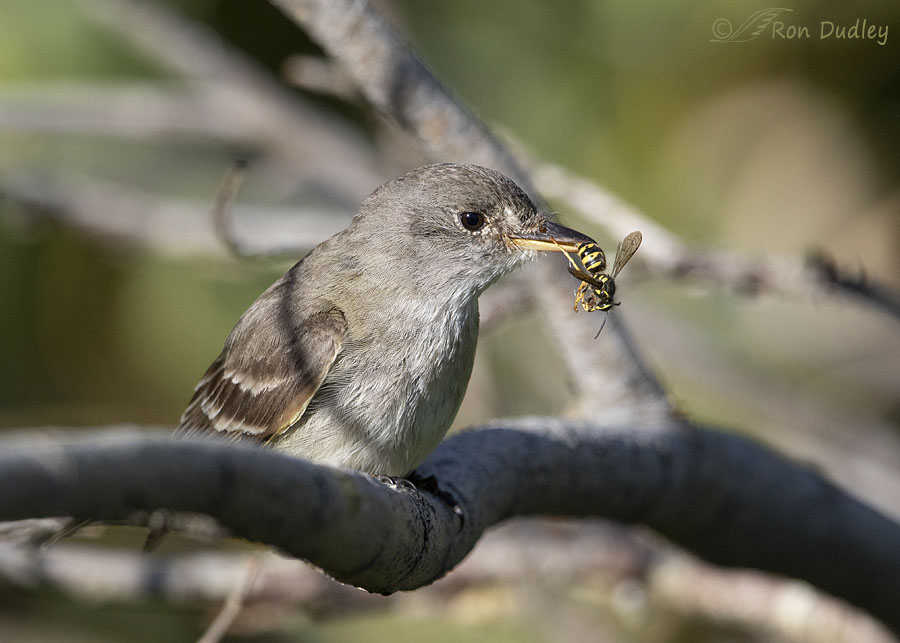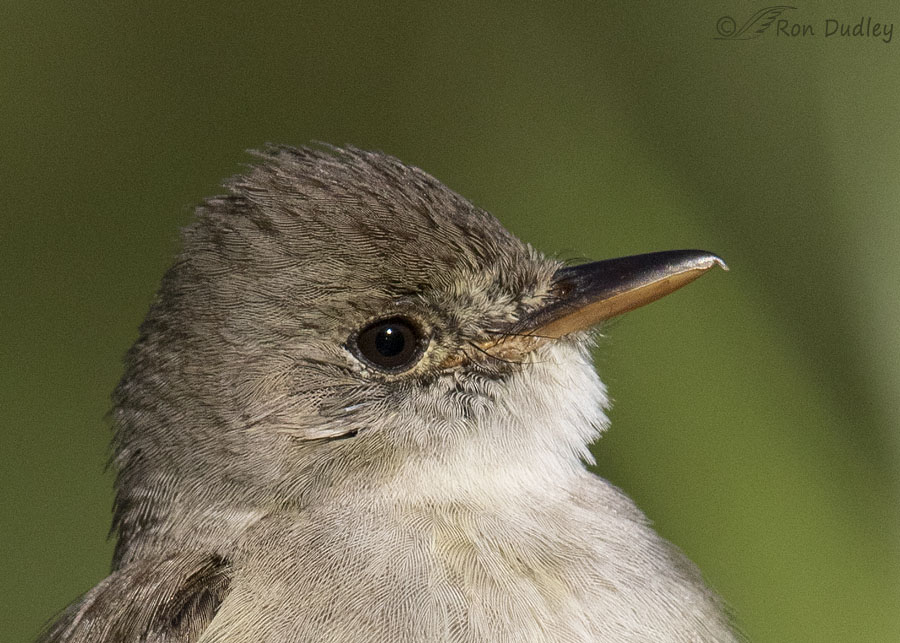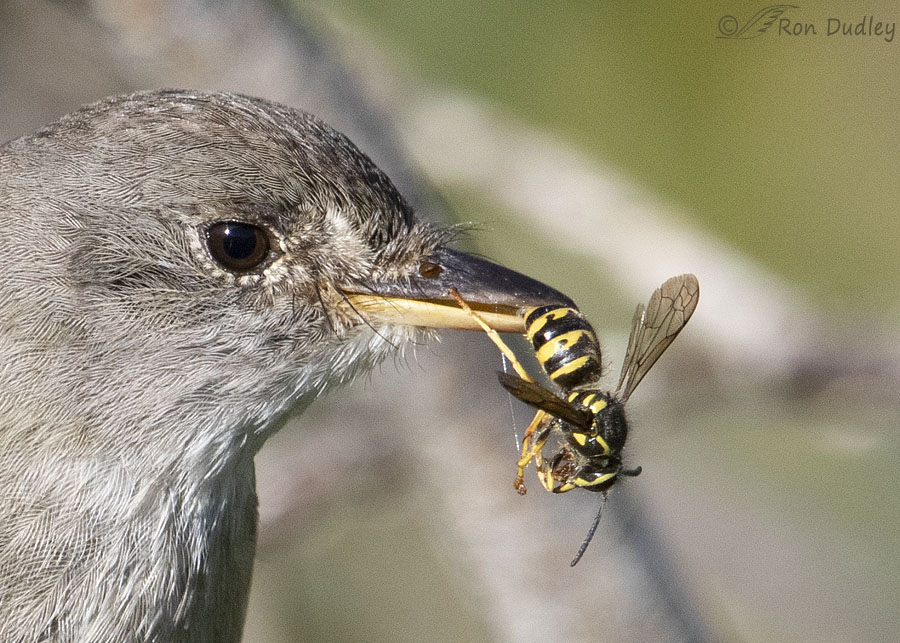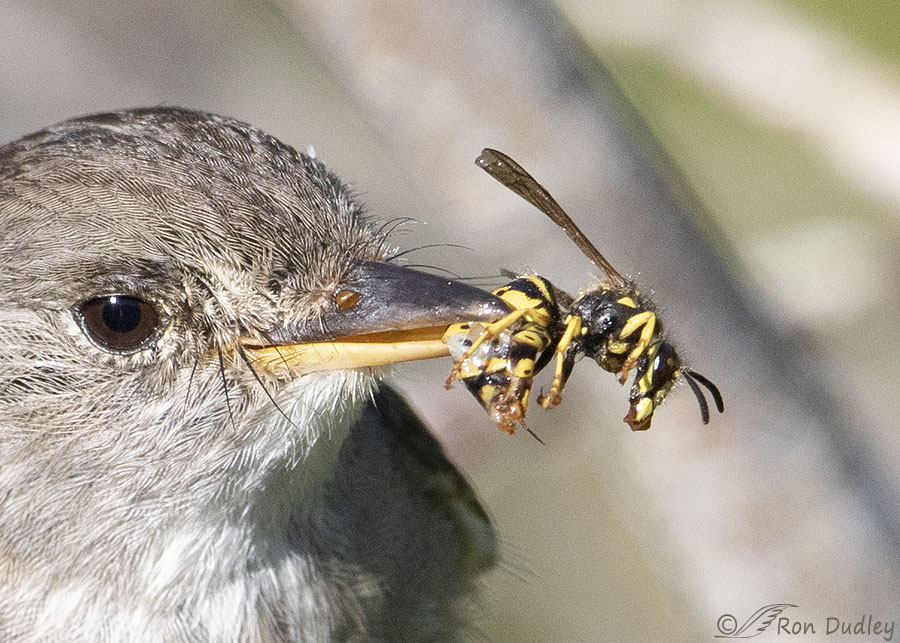Including a good look at the wasp’s stinger.

1/3200, f/6.3, ISO 800, Canon 7D Mark II, Canon EF 500mm f/4L IS II USM + EF 1.4 III Extender, not baited, set up or called in
Yesterday morning in the mountains this Willow Flycatcher landed close to me with a wasp in its bill. Obviously this photo (and the others I took) has issues, especially the out of focus perch snaking toward the viewer and in front of the bird, but with this close proximity I had a very good look at the wasp.
I’ve photographed a variety of songbirds with stinging insects as prey and they always seem to be very aware of the potential for being stung. They usually grasp it by its rear end since the stinger would have no effect on their horny bill and then make sure it’s dead before swallowing it. This flycatcher did that and for extra insurance beat the snot out of the wasp by slamming it against the perch multiple times. In the end that sucker was dead!

Flycatchers have hooked bills…

for very good reason. You wouldn’t want a pissed off wasp to get away and seek revenge before it was truly a goner. At this point the wasp was still alive and kicking, literally.

1/2500, f/6.3, ISO 800, Canon 7D Mark II, Canon EF 500mm f/4L IS II USM + EF 1.4 III Extender, not baited, set up or called in
In this later shot of the same bird we have a pretty darn good look at the business end of the wasp, its stinger. Sharp little bugger, isn’t it. And it’s long enough that it could penetrate multiple layers of feathers.
Stingers are modified ovipositors but unlike bee stingers wasp stingers are barbless so wasps can sting their victims multiple times. Usually the stinger is hidden inside a sheath but the trauma this wasp went through exposed it.
When it comes to wasp stings I’m a pansy-ass so I think I’d go without the meal rather than risk it. But if chocolate donuts could sting I’d be in big trouble.
Ron
Notes:
- I’m not 100% sure this is a Willow Flycatcher but I’m fairly confident of the ID. Empidonax flycatcher ID can be difficult.
- If you have no aversion to being stung here’s a potential profession you might want to consider. I had no idea there were professional “venom collectors”.


I bet when birds figure it out wasps can be fairly nutritious, as well as hornets and bees.
There is no thrill quite like reaching under the eaves during a gutter cleaning session and getting stung on the thumb!
George, think nothing of it try cleaning out a bird box with bare hands and the hand stumbled into a bumblebee nest! Not nice!!!
The bird nest was a House Sparrows nest.
Amazing wonderful series Ron!
Thanks for sharing!
Charlotte
Thank you, Charlotte.
Ron, the Willow Flycatcher obviously is experienced and smart. I don’t know if birds are smart and if so, are some smarter than others? The size of that stinger may be why their sting hurts so much. As far as the bee catchers, their comment that the stings still hurt is a little surprising. Thanks for a great post, Ron
Alice, their stings “hurt so much” because they inject toxins that evolved to be immediately and intensely painful so the insect has at least a chance to escape its tormentor before it is killed or seriously injured. And so that predators “in the know” will avoid them from the get-go.
Ron, thanks so much for the clarification about the toxins.
You’re very welcome, Alice.
500 hundred stings a year??? I wonder whether electricians get 500 shocks a year. I hope not. I really hope not.
I really can’t blame the willow flycatcher for its caution. Or the wasp for valiant attempts to sting its murderer.
I’ll have to ask my electrician brother-in-law, EC. He’s never dwelled on it as an occupational hazard.
Reminds me of a bumper sticker I saw 40+ years ago: Let an Electrician Check Your Shorts 😉
My brother in law’s getting nowhere near my shorts!
Terrific photos up close and personal! Looking at the flycatcher in your last photo I think I see a bit of a sneer telling me ‘and that’s how you handle these guys!’ I’ve seen them ‘beating the snot out’ and they show no mercy! They are pros in that department. 😠
Kathy, this guy put so much effort into beating up on the wasp it almost fell off the perch. Three times!
Looks like a yellow jacket to me…not a wasp…I think wasp tend to be brown and to bite, not to sting. And bees and yellow jackets to sting…..but what do I know…great photos!!!
Patty, yellow jackets are types of wasps.
Wasps are capable of both biting and stinging but they very often sting.
Ron. You got a catch light in every photo. Amazing. And I’ve never seen a wasp close up. Thanks Diana
Usually when we see a wasp this close it’s painful… 🙂
Wow! That is one skilled Flycatcher. Excellent detail of both the bird and the wasp, Ron — these are great shots.
I’m living life on the edge right now. I have a paper wasp nest going up on the front walkway and a huge feral honeybee hive in my neighbor’s tree that’s right next to my driveway. So far, so good, although the bees have scared away the hummingbirds that used to hang out in that tree. I’m OK with the wasps right now as they seem to be pretty docile and are helping to keep the mosquito population by my front door down.
Thank you, Marty. Good luck in the sting department!
I’m still amazed at the level of detail you achieve in your photography. Rictal bristles appear even sharper than your previous post in which you explained their probable function (although looking at the last shot I wonder if they might not also have a protective pupose).
Having watched the video link, the venom collector say he gets stung up to 500 times a year. I get stung 2 or 3 times a year, usually while filling the bird feeder where the wasps build their nests in the squirrel baffle. 500 times would put me in the nuthouse. I think I’ll get one of those suits to wear per the video. Then the neighbor would probably call the guys in white suits.
I don’t always get that much detail, Lyle. It has to be perfectly sharp to get that detail when it’s blown up to this size and that doesn’t always happen. But when I do get it I can thank my high quality lens for it. It makes a huge difference in detail and sharpness.
Ha, having the neighbors call the guys in white suits would still be preferable to 500 stings!
Wonderful “close-captures”………I was interested in the bird’s nostril–it appears to have a membrane over it. Is that an interior membrane “puffed” out for protection,
or does it always look like that ? I never paid any attention to birds’ nostrils in the past !
I noticed that too, Kris. My guess is that what we’re seeing is inside the nostril (though I realize it looks convex), perhaps a mucous membrane in there.
That is a great close up of the Flycatcher and the wasp. In that last shot the wasp really does look beat up. Guess the Flycatcher was taking no chances. Two years ago we had late season bees construct a huge hive on a corner wall out back. One fun thing to watch was a Say’s Phoebe who quite often would just fly over and pick off a bee and eat it. We called a local bee guy to come remove them and he said there were about 10,000 bees there. He had to destroy and remove the bees. It was too late in the season for him to take them back to his place and they would have frozen to death anyway if left where they were. But before he got here that Say’s Phoebe was having a feast.
Thanks, Everett. Sounds like your bees were screwed no matter what happened and that’s too bad.
Smart bird! I’m pretty wossy about wasps also – particularly the big black headed jobbies! ;( Had a dog chase a regular wasp up my pant leg as a kid – couldn’t get the pants off fast enough! The flycatcher was definitely mashing the heck out of it before eating it……;) Great capture even if not technically “perfect”……..
“couldn’t get the pants off fast enough”
I was in that boat once too, Judy. Though in my case the critter of concern was a huge leech on the back of my knee that was engorged with my blood. Freaked me out more than just a little…
Your comment makes me think of the leech scene in Stand by Me.
How about a rerun, Marty!
https://www.youtube.com/watch?v=V4jg8o9wXys
This one ain’t bad either, but then I’ve always loved Bogart and Hepburn.
Funny! 🙂 Leaches never bothered me much tho certainly didn’t let them “hang around”……. 😉
Poor Will Wheaton! I don’t know what I’d do if I found a leech on my bangers and mash (of course, being female, having bangers and mash might be the bigger surprise).
I love African Queen — apparently both of them became pretty ill from being in that water.
Ah come on I loved that scene! VBG!
What fabulous photos. Wasps give me the heebie-jeebies, too, but this pretty flycatcher clearly decided it had the skills to up its game and take on something other than a fly.
He was pretty darned careful about it but he was up to the challenge. Thanks, Shoreacres.